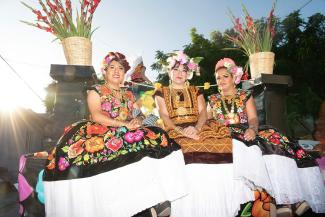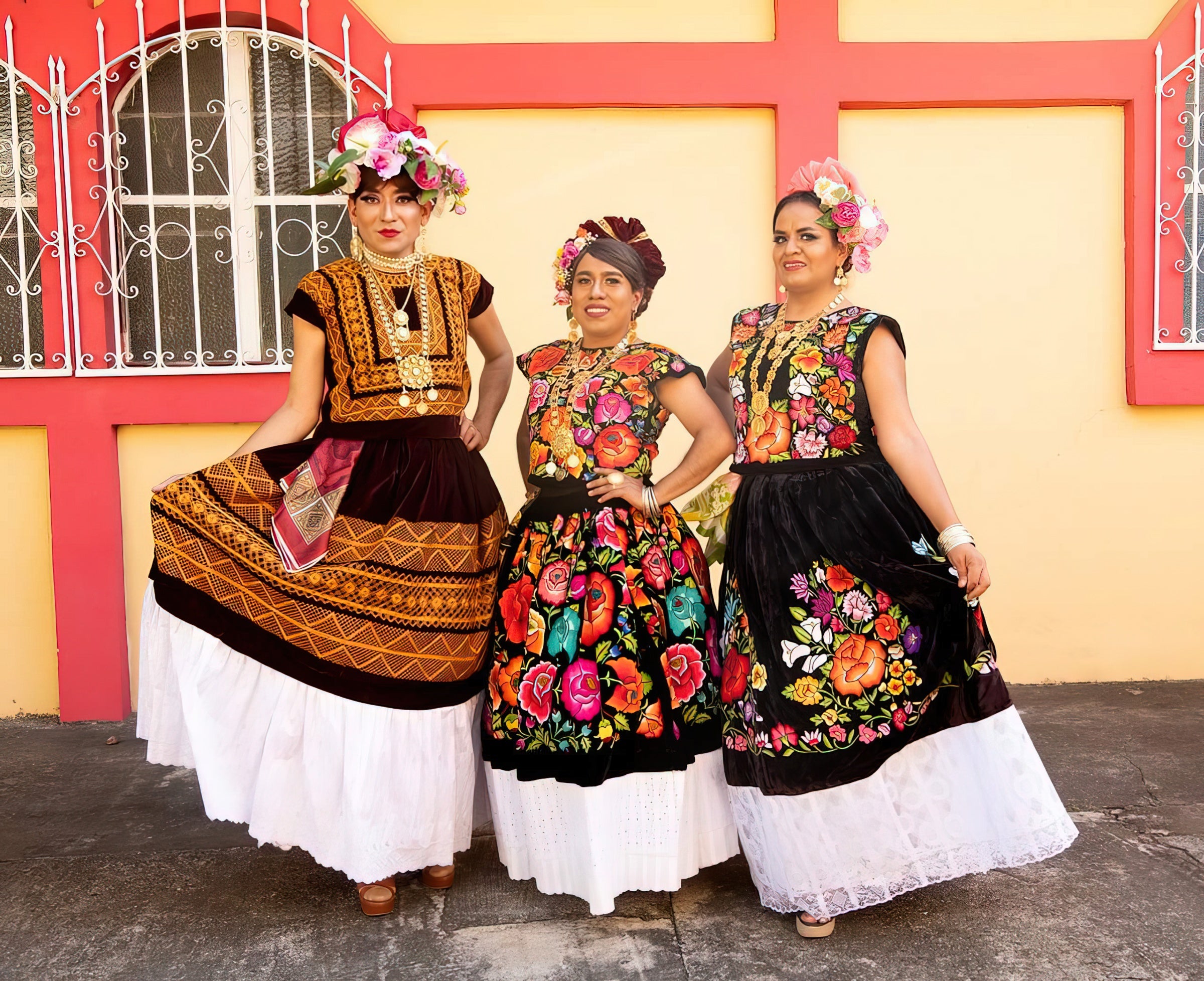
The Isthmus of Tehuantepec is located in the southeast of Mexico between the states of Oaxaca and Veracruz. It is a region of diversity and cultural richness and is the cradle of the Binnizá (Zapotec) Peoples. Juchitán de Zaragoza is one of the most recognized cities in the region and is known for being the home of the Muxes, an Indigenous third-gender community known since pre-Columbian times. The Muxes have recently been attracting international attention by challenging the binary and gender roles imposed by settler colonialism, with Muxe activists working to raise their voices and push for the inclusion of their community nationally and internationally. Such is the case of the Colectivo Verbena Muxe, which has been gaining visibility and recognition for organizing their cultural demonstrations in other states in Mexico to promote the rights and inclusion of the Muxe community.
There are two types of Muxe people, the gunaa and the nguiiu. The gunaa are people who were born as men but identify as women, are attracted to men, and take on female roles in society. Nguiiu Muxes were born as men and are attracted to other men, but do not dress or identify as women. From the Western and predominant view in today’s general culture, Muxes are usually considered part of the 2SLGBTQ+ community. However, this classification distorts the concept of the third gender by reflecting a culture that historically recognizes only two genders based on the sex assigned at birth. For Lukas Avendaño (Zapotec), an anthropologist and artist, it is difficult to find a single definition of Muxe due to the many layers of Muxe identity in which not everyone identifies in the same way, and which defies heteronormativity.
In much of the existing literature about Muxes, it is said that they are widely accepted in their community and are considered an important part of their culture, and not something alien or new. However, it has not always been easy for them. Historically, Muxes have also been oppressed by some members of their community due to the prevailing machismo. This is the story of Joseline Sosa (Zapotec), who says that since she was a child, her family did not let her be who she was and she had to dress up in secret. Having a Muxe person in the family is often considered a blessing because there is a belief that they would stay at home their whole lives to work and take care of their family. Muxes tend to be assigned tasks associated with a female gender role, denying them certain professional opportunities, or in some cases, even an education. They frequently work as seamstresses, shopkeepers, or emigrate to other states or countries.
As Karla Rey (Zapotec), Muxe activist, comments in an interview with Cultural Survival, although historically Muxes have had challenges related to discrimination, homophobia, transphobia, and muxephobia, they have found acceptance. “Muxes have been very important figures within families, within society, even within the Zapotec matriarchy,” Rey explains. With this optimistic outlook, Rey and other compañeras formed the Colectivo Verbena Muxe in 2017 in the wake of a series of earthquakes that hit the Isthmus of Tehuantepec. One of the earthquakes was considered to be the largest in magnitude in almost 100 years and strongly affected the villagers, leaving many homeless and without their most precious belongings. Rey, Founder and President of the Colectivo, says they began by organizing a craft fair. They wanted to support some of the most affected Muxe in the region because “they all consider themselves as brothers and sisters.”

L-R: Malintzin, Naela, Karla Rey.
Rey says that little by little, more Muxe joined the group, such as Naila López (Zapotec) and Malintzin (Zapotec), and the Colectivo became more diverse and multidisciplinary. They began to capture the attention of more people and were invited to major events such as the Heart of Mexico Festival, as well as to teach dance classes of son and faldeo istmeño by the National Dance Coordination. Through such activities, they have been achieving their mission of the dissemination and inclusion of the Muxe community through cultural activities such as dance presentations, embroidery workshops, and lectures on their traditions and customs.
Similar to the Colectivo Verbena Muxe, there are other activists who seek to amplify the voices of their fellow Muxes and demonstrate their pride. Among them, Estrella Vázquez (Zapotec) has been featured nationally and internationally for being the first Muxe to appear on the cover of one of the country’s most popular magazines, Vogue Mexico & Latin America in 2019. Pedro Enrique Godínez Gutiérrez (Zapotec), better known as “La Kika,” for her activism of more than 20 years, is also a well known Muxe from the area. And the documentary “Muxes,” available on HBO Max, features Muxes recounting some of the challenges they have lived through history and how they have promoted their identity and resistance through culture by means of festivities known as Velas Istmeñas.
Like Rey, many Muxe have been forced to leave their communities in search of a better life, especially after the ravages of the COVID-19 pandemic. Rey says that they have appeared in different spaces such as universities, 2SLGBTQ+ community bars, marches, and other festivities, wearing their textiles as part of a political resistance. She says that they go to these places to honor their roots, doing things “with the heart, sharing who we are, that we are present, that we want to leave a legacy, that we want to be an example...to say that yes, we can live with pride, and say ‘this is my root, this is my culture, this is me,’ and proudly wear my costume, speak my language, and say ‘I am proudly Indigenous Oaxacan, I am Mexican, I am Muxe.’”
Rey says the Colectivo seeks to positively influence new generations to continue with their legacies, because although she was born in a time when they could already use their traditional dress and be more free, the challenge is to “leave a legacy that we strengthen, that we make new spaces for new generations like ours, that it is seen that our pride in being Muxe goes beyond and that we want more things and that we want to reach happiness at the end of the rainbow.” She urges Indigenous children and youth to feel “proud of who they are, of their legacy, of their parents, of their grandparents, of their culture, that they never stop speaking their language, wearing their costumes and carrying their roots, who they are and who we are, that they never feel less than because we are, we resist, and we are still present. It is in us and in you to continue preserving a beautiful legacy of each one of you, of your people, of your culture.”
In Mexico, where macho and patriarchal attitudes still prevail, the visibility, promotion, and inclusion of third-gender people through culture, as in the case of the Muxes, breaks the paradigms and concepts that have been imposed on Indigenous Peoples by colonialism. The third gender challenges the gender binary, heteronormativity, and the patriarchy. Muxes want it to be known that they have always been here, and that other gender identities have existed since pre-colonial times.
Photos by Shazia Khan.
